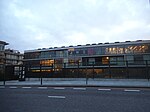Frognal and Fitzjohns (ward)

Frognal and Fitzjohns is a ward in the London Borough of Camden, the United Kingdom. It covers the western areas of Hampstead, between Hampstead Village and Finchley Road and takes its name from Frognal and Fitzjohn's Avenue. Like all other wards of Camden, Frognal and Fitzjohns is represented by three councillors on Camden Borough Council. These councillors are currently Siobhan Baillie, Andrew Mennear and Gio Spinella, all of the Conservative Party. The population of this ward at the 2011 Census was 11,986.The ward will be abolished for the 2022 election, and part of its area will become the newly created Frognal ward, with a smaller area transferred to Belsize.
Excerpt from the Wikipedia article Frognal and Fitzjohns (ward) (License: CC BY-SA 3.0, Authors, Images).Frognal and Fitzjohns (ward)
Chesterford Gardens, London West Hampstead (London Borough of Camden)
Geographical coordinates (GPS) Address Nearby Places Show on map
Geographical coordinates (GPS)
| Latitude | Longitude |
|---|---|
| N 51.555 ° | E -0.184 ° |
Address
Chesterford Gardens 30
NW3 7DE London, West Hampstead (London Borough of Camden)
England, United Kingdom
Open on Google Maps









